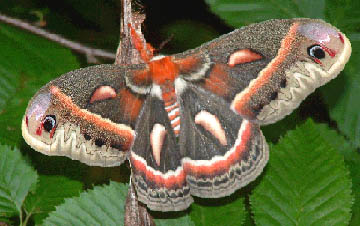An Adventure.....
..... to rear such creatures from their humble beginnings, to the final beautiful adult stage!
Believe it or not, even in the wild - even in the very best of natural conditions - only about one in 200 survives to adulthood! Yes, the larvae have untold enemies that feed on them....... starting from the day they hatch......... and even before that!
Those that survive the gnat-sized flying egg-parasites before they even hatch fall prey to spiders mostly....... and don't forget about stink bugs, that literally suck them dry with the help of a tiny needle. Plus wasps and yellow jackets take their toll when the larvae are small.
Then comes the mid-size stage, when birds do most of the damage, and in fact, these larvae are in some cases the absolute #1 food for many of our birds, and it's because of these caterpillars we have such birds as the Cuckoos (ever heard of a cuckoo clock??!), and the Vireos........ and countless types of Warblers! In fact MOST of our birds turn to a caterpillar-diet during the summer months, which gives them their much-needed protein!
When these larvae "outgrow the birds" so to speak, then comes their greatest risk! Tiny parasites do most of the damage, and will take out all but a precious FEW of the remaining larvae. These tiny creatures come in many shapes and sizes, and are all out for one mission: To eat the caterpillars from the inside-out! Yes, there are many types of smaller insects (wasps and flies) that make a living by closely hovering over every leaf, and searching the whole day thru to find a host to lay eggs on (or in some cases, inside of!), and once this happens, their fate is forever SEALED!
Yes, the tiny larvae (of the parasites) soon hatch and begin feeding inside the caterpillar - which in many cases continues to live a normal life - seemingly unaware of the "problem" just under its skin! The caterpillar often goes all the way to pupation (when it makes a cocoon for example), and by then the parasites are large, and will finish their deadly work......... and when the time arrives, instead of a beautiful adult.......... a wasp (or a BUNCH of wasps!), or a swarm of flies emerge instead - so keep this in mind if you find a wild cocoon, or bring home a caterpillar that you did not hatch out yourself!
Finally....... the long-awaited day has arrived...... but OOPS!! One last deadly enemy to contend with: The viral and bacterial world! These totally invisible killers can kill off whole colonies of larvae! In many cases this can be a good thing, but it can be very sad when this happens to your "pets"! These so-called diseases are often released on purpose to keep such pests as the Gypsy Moth under control, and they even sell "B.T. powder" in most garden shops, which is deadly to caterpillars........ and so I say HERE, it's best to wash off the leaves you feed your larvae, especially when they reach a large size, because it's when the larvae get BIG they are most prone to these invisible killers - who seem to have no other purpose than to make life miserable for caterpillars (similar "diseases" include the common cold and the flu - in people). Have no fears though...... unless you are a caterpillar, there's no chance of catching any of these diseases.
Finally.......... the few remaining ones reach the pupal stage! Are they safe yet?? Not hardly! Woodpeckers and rodents spend the winter months tearing open cocoons and eating the pupae inside (Pupa - the mummy-like stage which the larvae go into after their larval stage. ALL caterpillars form a pupa - some inside a cocoon - and some NOT. Most pupae are formed underground. Also "pupae" is plural for "pupa"). Floods take their toll of pupae, as well as always-hungry moles and shrews during the cold months, and finally those that are not consumed by ants when the weather warms will finally hatch into the long-awaited adults! (Whew!!).
So therefore my friends please don't fret if some of your larvae don't make it! Be thankful for those that do, and take each loss as a learning tool on how to do it BETTER next year! I've been doing this since 1981, and I have seen a variety of things happen in rearing these beautiful giant moths, and I wanted to start out right in the beginning to let you know there are "many strikes AGAINST you" as you venture into this strange yet fascinating hobby!
You will also soon discover this is not one of those Web pages plastered with pretty moth pictures, range maps, or other common info so easily found elsewhere on the Web..... or in books, but this is being written so you can take these moths and raise them yourself, which is information that seems to be lacking for most part, especially here in the U.S. with its "hands off all wildlife" philosophy. Anyways I have had great joy in doing this, and will very freely pass this info along to others who want to venture into this!
|


 (This is a female Cecropia, Ex-Ova, Athens County, Ohio)
(This is a female Cecropia, Ex-Ova, Athens County, Ohio)